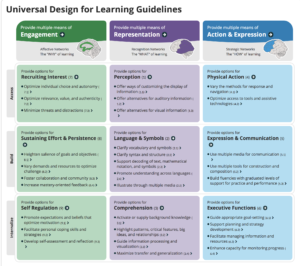The future state of learning openly and in a distributed way in the year 2040 is up for debate. However, by taking the course- EDCI 339, it has enabled me with a wealth of knowledge in relation to learning design. By doing so, this allows me to make an educated personal opinion on what education in the future might entail.
The EDCI 339 course outcomes embodies key concepts, relating to an introduction to the practice of learning design and its application to interactive learning environments.
With the technological advancements already available in the current year of 2020, I foresee a giant leap in the betterment of online platforms as they will act as a medium between instructors and students in the world of academia. In my futuristic story in the setting of 2040, there is an heavy incorporation of strict guidelines of the OEP and OER to ensure consistent educational sources for school environments. UDL principles play a great part in online learning, and the adoption of Artificial Intelligence (AI) and machine-learning will heighten the learning experiences for students. My final project post will take the form of 4 main pillar guidelines, and explore each concept in detail and relate their importance to the future of education.
My prediction of education in the year 2040 explores 4 main framework pillars:
-Humanizing online platform teaching and learning.
-UDL core principle guidelines.
-Open Educational Resources (OER).
-Future tech (Artificial Intelligence, Chatbots, Video Learning).
PILLAR 1
I believe there is great merit and importance for future education to be humanized. Cathy Barnes outlines the importance of humanizing online teaching and learning into three sub-categories:
- Cognitive Presence
- Instructor/Teaching Presence
- Social Presence
The Col (Community of Inquiry) Framework reflects a mergence of three presence theories. The entities of social presence, cognitive presence and teaching presence are inseparable as they share many commonalities; and works together to form an enhanced educational experience. “Dewy asserts that interaction is vital for students to adapt and learn from their surroundings; whereas Vygotsky’s social constructivist’s theory contend that knowledge is co-constructed within a community” (Chen, No Date). A hands-on approach to teaching is often overlooked as an influx of online learning materials are made available to students. A constructive improvement would be to try and mimic the in-person classroom experience with live-webinars; adding the social and teaching presence into the overall educational experience.

The Community of Inquiry characterizes instructor presence as an important key component “for creating community and affecting learning outcomes” (Barnes, 2017). The framework discusses the importance of instructor presence, as it “promotes social presence and heighten the sustainability of cognitive presence” (Chen, No Date). An outcome of the study exemplifies that teaching presence promoted student participation and discussions. An example of this when an instructor distribute a survey to students, and the students in turn fills out the survey in direct response. This instance illustrates a correspondence between all parties as direct result of the instructor’s prompt [presence].
In the realm of education in the future, students are expected to participate in their respective courses behind computer screens. By incorporating the Community of Inquiry framework, instructor can help boost engagement from students in the course. By doing so, it also encourages a human-touch in the midst of heavily computerized learning platforms and e-books. An example of this is as simple as the participation in a discussion or forum site, where students are able to post questions and receive responses from instructors; in the form of a post or direct message.
PILLAR 2
The UDL principles encourage instructors to provide students with multiple means of engagement, representation and actions and expression. UDL framework is a strong guideline for contents-design and defines expression applications in course-work. The principles of providing different means of engagement can easily include the incorporation of technologies like ZOOM and Microsoft Teams to deliver online discussions between instructor and students (Dickinson & Gronseth, 2020).

In the sphere of futuristic education, the lack of human to human interaction in educational settings can pose as a problem. An example and a remedy to this is the creation of a class social-hub, also commonly known as break-out rooms. The purpose of this is for instructors to open-up a period in the day for office hours. This further enforces UDL guidelines to ensure that students in online course have the opportunity to express and articulate course related materials with their instructors. On the whole, the end goal of UDL incorporation provide multiple means of engagement, representation, and action & expression.
PILLAR 3
Open Educational Resources (OERs) are teaching, learning and research materials in different formats. The OER reside in the public domain or have been released under an open license that permits no-cost access, use, adaptation and redistribution by others with no or limited restrictions. (UNESCO, 2018, p. 2). In a way, textbooks and course materials can all be unified and stored within the OER.
In the educational setting of 2040, it can be assumed that many services will be subscriptions based. In the current times, common subscriptions to music and movies such as Spotify and Netflix are very commonplace. In the realm of academia, educational services will be subscription-focused while offering an all-inclusive access to students and instructors. As an example, students will no longer be required to purchase textbook and reading materials as their education subscription service will provide them access to ebooks and learning materials online. Furthermore, the need for traditional methods of students having to visit school libraries for academic journals and specialized book volumes; can be mitigated with secure virtual private access (VPN) from the comforts of home. In a simplified manner, Open Educational Resources helps to make accessibility to online learning more attainable. At the same time, OER helps to streamline the overall user learning experience and negates obstructions such as difficulty obtaining course materials as an example.
PILLAR 4
The new generation of learning
Although some might view technology as pervasive, for the new generation of learners, technology will be heart of academia platforms and learning. It can be assumed that both children and adults will be very digitally savvy and heavily rely on the internet. The COVID-19 pandemic has already thrusted online learning to new heights. By 2040, a student-focused approach of learning design can allow children to choose their own learning objectives and their own pace- all of which can be guided by artificial intelligence, chatbots, and video-based learning.
Artificial Intelligence
Artificial intelligence (AI) in education typically focuses on identifying what a student does or doesn’t know, and then subsequently developing a personalized curricula for each student.
The employment of AI in educational capacities has garnered great attention, and by 2040, AI will play a key role in schools. What AI will do is to use a mixture of user-based interactions and machine-learning to better analyze information. Over time, AI can interpret a big collection of big data to improve learning materials provided by schools.
In an purported example, an online assessment is provided to a class of students. And after careful analysis of the completed assessments, the AI can be utilized identify certain questions in the assessment that the majority of students answered incorrectly. By doing so, the instructor can better single-out deficiencies in learning-materials that might have caused this; in relation to the wrongly answered questions.
In short, the adoption of AI and machine-learning gained great momentum in recent years, and will continue to do so in the near future. AI helps course designers and instructors cater to a growing number of students partaking in online learning.
Chatbots
Chatbots are increasing in popularity and becoming a fundamental tool in next generation education. Chatbots are designed and aim to simplify the interaction between student and computer, and some benefits may include:
- Spaced interval learning: Uses algorithms and to calculate user memorization and information retention.
- Immediate feedback: Papers, quizzes, and exams can be graded instantly, providing near immediate results.
- Self-paced learning: Closely tailor and track a student’s learning performance.
Essentially, the adoption of chatbots will enable reduced workloads on instructors, and help to facilitate course materials to a large number of student all at once.

Video Learning
Video-based learning has slowly gained acceptance in schools and is greatly considered a learning innovation. By incorporating videos into online course curriculums, it empowers students to view videos at their own leisure and as well have flexibility of replaying videos when needed.
The usage of videos in educational capacities provides:
- Educational material for student course work.
- Verbal feedback on assignments.
- Instructional and step-by-step directions for students to follow.

References
Brau, B. (2020). Constructivism. In R. Kimmons & scaskurlu (Eds.), The Students’ Guide to Learning Design and Research. EdTech Books. https://edtechbooks.org/studentguide/constructivism
Chen, A. (No Date). EDCI 339 Student Blog. https://andrewc.opened.ca/
Dickinson, K. J., & Gronseth, S. L. (2020). Application of Universal Design for Learning (UDL) Principles to Surgical Education During the COVID-19 Pandemic. Journal of surgical education, 77(5), 1008–1012. https://doi.org/10.1016/j.jsurg.2020.06.005
Garrison, D. R., Anderson, T., & Archer, W. (2000). Critical inquiry in a text-based environment: Computer conferencing in higher education. The Internet and Higher Education, 2(2), 87-105.
Johns, H. U. P. (2015). Teaching online : A guide to theory, research, and practice. ProQuest Ebook Central https://ebookcentral-proquest-com.ezproxy.library.uvic.ca
“The UDL Guidelines.” UDL, 6 Oct. 2020, udlguidelines.cast.org/.
“Learning Pathways: Open Education Online Tutorials: OER Africa.” Learning Pathways: Open Education Online Tutorials | OER Africa, www.oerafrica.org/book/learning-pathways-open-education-online-tutorials.
Leave a Reply